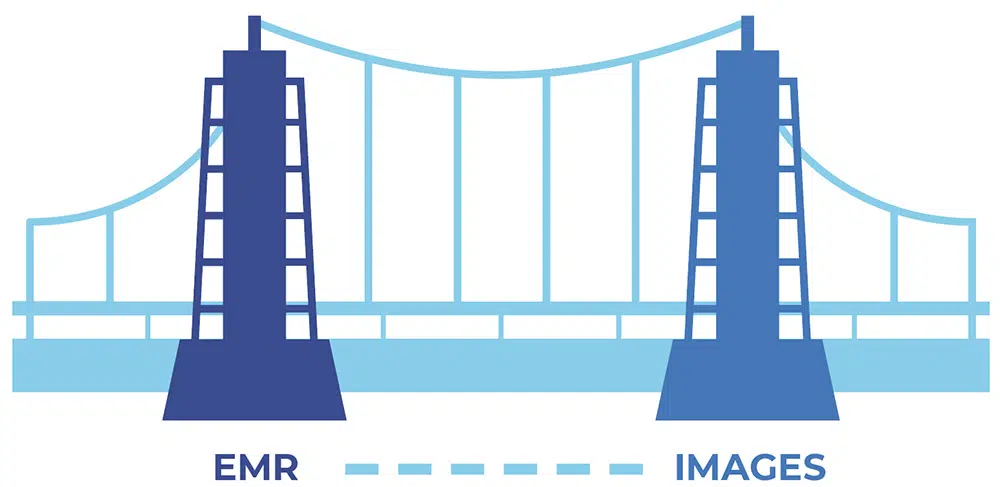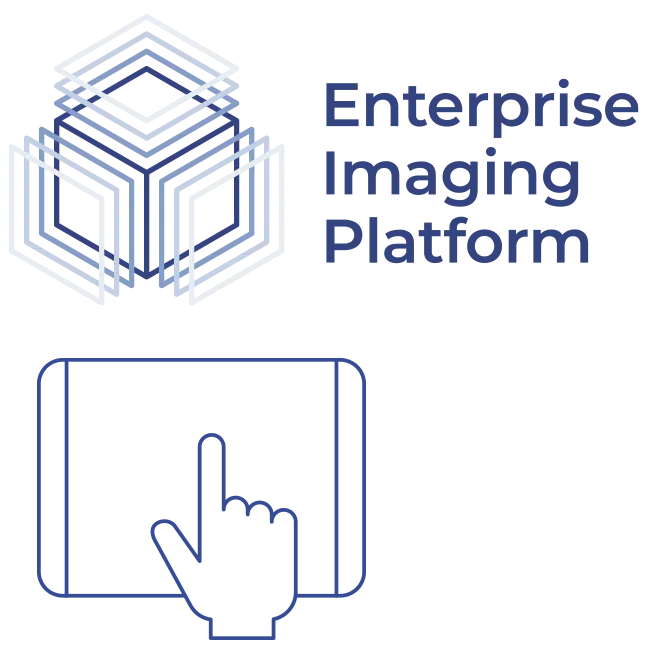
An interview with
RJ Merck RT(R),
Radiology IT Supervisor,
Zuckerberg San Francisco General Hospital

‘Two towers’ strategy helps make the hospital’s vision for uniting image and data into a reality.
With Enterprise Imaging, Zuckerberg San Francisco General Hospital bridges imaging gap in the EMR.
With a vision of making all care and all images from all patients accessible across the care continuum, Zuckerberg San Francisco General Hospital has long been focussed on its journey to “Go all in” on enterprise-wide image management.

The hospital’s deeply knowledgeable team of imaging IT experts has worked closely with Agfa HealthCare to expand the imaging strategy and expertise across the entire organization, and to support the delivery of high-impact care. The result? A ‘two-tower’ strategy that integrates the EMR platform with the Enterprise Imaging platform, to create a single, image-enabled electronic medical record for the patient.
Starting with a patient-centric perspective
For Zuckerberg San Francisco General Hospital, in California, USA, the journey to Enterprise imaging began over a decade ago, in the field of telehealth.
“We became aware that for certain types of services, especially ophthalmology (diabetic retinal screening, for example) and dermatology, there were opportunities to provide care for patients, without a hospital visit. Instead, patients could go to a local clinic for screening and imaging, and then the specialists at the hospital could read the images remotely,” explains RJ Merck, Radiology IT Supervisor at Zuckerberg San Francisco General.
 “The system was so successful that we reduced the waiting time for a dermatology appointment from 6 months to 30 days. It was clear this was a winning strategy, for our patients and our own operational efficiency. So while we invested in expanding the frontend telehealth systems in our consortium clinics, we also began building a backend – the beginning architecture of an enterprise-wide imaging solution.”
“The system was so successful that we reduced the waiting time for a dermatology appointment from 6 months to 30 days. It was clear this was a winning strategy, for our patients and our own operational efficiency. So while we invested in expanding the frontend telehealth systems in our consortium clinics, we also began building a backend – the beginning architecture of an enterprise-wide imaging solution.”

“The ‘Big Bang’ implementation of Enterprise Imaging for Radiology went very smoothly, thanks in large part to the Agfa HealthCare engineers and trainers on site.”
RJ Merck,
Radiology IT Supervisor
Methodical, multi-year transition to a centralized solution
These initial phases involved the creation of multiple ‘small image enterprises’, using individual servers. But the hospital was already looking for ways to combine ease of use and integration for the different sites, departments and specialties, with a single, centralized backend system for managing and archiving all images, regardless of format. An upgrade of the hospital’s existing Agfa HealthCare image management system in 2011 provided the opportunity. But, as Merck explains, “we couldn’t yet make the conversion to a single system: frontend and backend were still separate.”
In October 2016 the hospital decided to take the next big step forward, by implementing the Enterprise Imaging platform. “We chose to start with mammography as a pilot, for very practical reasons: the unit’s imaging system was at its end of life, and as a more ‘9-to-5, Monday to Friday’ environment, mammography gave more flexibility to try different things. We were able to work out issues, such as around storage and clients, and we learned a lot!”
Following this success, in November 2018 the hospital was ready to transform the entire radiology department to Enterprise Imaging. The ‘Big Bang’ implementation went very smoothly, thanks in large part to the Agfa HealthCare engineers and trainers on site, according to Merck.
“Our set-up is a bit unusual, as we have a dedicated imaging IT team of four experts with a very deep knowledge of imaging and digital image transfer. Together with the Agfa HealthCare team, this enabled us to move very quickly towards Enterprise Imaging for Radiology.”
RJ Merck,
Radiology IT Supervisor
Consolidating ‘ologies’ in the imaging ecosystem
The hospital can now bring other departments into this centralized imaging ecosystem, while some are maintaining their own frontend software and systems.
Cardiology, for example, uses a small PACS that fulfills the department’s main requirements and integrates well with the equipment. However, it did not allow long-term archiving, and clinicians outside this ‘cardiology silo’ could not see the patients’ images and reports. “Within the Enterprise Imaging platform, we created a background archive that works with the frontend system, while also allowing other clinicians to click on a link to view the images and reports, and see the patient’s continuity of care.”
Ophthalmology and dermatology have also already been connected, and the hospital is looking to integrate other departments and service lines in the Enterprise Imaging, such as the gastro-intestinal group and the many ultrasound devices spread around the hospital.

Two towers, one image-enabled patient record
At the heart of Zuckerberg General’s imaging strategy are two separate yet connected towers: the EMR and the central image repository.
“When we implemented our new EMR, the game changed. All image orders, from all image-producing departments, go to this unified EMR. This means we now have a single order placer that works with a single imaging repository. These two towers define the patient’s image-enabled medical record.
At the same time, the bridge between the two towers is seamless for the users: they make the order for an exam in the EMR, and can then access the images, data, orders, billing, demographics, etc., anywhere. Non-radiology clinicians can see the images using the XERO viewer. This set-up gives us a lot of flexibility and scalability on how we want to do things.”

Accessing the complete patient history
The two-tower strategy with Enterprise Imaging enhances patient care in departments across the hospital: for example, the trauma department and its very busy orthopedics center, he explains.
“Trauma patients often receive their first treatment, and images, in the Emergency Department. They are then moved to the orthopedics clinic for continuing treatment. With Enterprise Imaging, the orthopedist can see everything done in the Emergency Department, and include that in the patient’s care plan. And if the trauma patient is re-injured (which happens with some frequency) and again treated in the Emergency Department or any other department or consortium clinic, the orthopedist has access to the complete history, allowing true continuity of care.
Wherever the patient receives care throughout the hospital, all caregivers are referring to the same patient medical record, including imaging. Nothing falls through the cracks for the individual patient.”
“The relationship with Agfa HealthCare has always been a partnership. We had a direction, not a step-by-step path, and that meant there have been plenty of changes along the way. The Agfa HealthCare team’s attitude is ‘OK, let’s get it fixed, let’s do this’.”
RJ Merck,
Radiology IT Supervisor
A dedicated imaging IT team
One of the biggest non-technical challenges of the large-scale project, explains RJ Merck, is creating governance and managing change. “Our set-up is a bit unusual, as we have a dedicated imaging IT team of four experts with a very deep knowledge of imaging and digital image transfer. Together with the Agfa HealthCare team, this enabled us to move very quickly towards Enterprise Imaging for Radiology. But when rolling out the centralized system to other departments, we have to get everyone on board.”
Before implementing the Enterprise Imaging platform, this team focused solely on radiology IT, he explains. “But now we handle imaging from ophthalmology, to dermatology, to cardiology and more, throughout the hospital. This small team, with its deep experience in PACS, DICOM, HL7, and other imaging-focused skills, can act as the tip of the spear for our IT work.”
“Wherever the patient receives care throughout the hospital, all caregivers are referring to the same patient medical record, including imaging. Nothing falls through the cracks for the individual patient.”
RJ Merck,
Radiology IT Supervisor
‘Build it and they will come’
Merck offers the example of Emergency Department ultrasounds to illustrate both the difficulty of implementing change, and the clinical benefits of the solution. “Order entry is key to ensuring every stored image has complete identification information. However, not all departments included this step in their traditional imaging workflow.
The Emergency Department staff, for example, do a lot of bedside ultrasounds. Previously, they would simply send the images to radiology, who would then have to try to work out patient identification, exams, etc. We now needed the Emergency Department staff to fill in order entries themselves for the ultrasounds they were carrying out.
Luckily, we were able to show them how easy it is to pull up a patient’s priors, when exams have been ordered in a systematic way. As a city and country health provider, we have many patients who return to the Emergency Department multiple times, so fast access to the patient’s complete imaging history is a clear benefit for the staff. Now, they are much more willing to place the orders, with all the needed details.”
The gastro-intestinal group had a similar issue. “They do a lot of volume-rendered cholangiopancreatographies (ERCPs) and other scans in their clinic. These can be stored as ‘outside images’ in Enterprise Imaging, but by creating orders that get sent to Enterprise Imaging, the images become part of the ecosystem.
Our philosophy is to overcome potential resistance by giving each department solutions and benefits that meet their needs and offer them tangible value to enhance care. That is why I say ‘build it and they will come’.”

A shared ‘all-in’ vision
A key factor in the success of the project, highlights Merck, is that Agfa HealthCare has shared the hospital’s ‘all-in’ vision, from the start. “It has always been a partnership. We had a direction, not a step-by-step path, and that meant there have been plenty of changes along the way. The Agfa HealthCare team’s attitude is ‘OK, let’s get it fixed, let’s do this’. As a result, I always feel backed up by Agfa HealthCare. I have the confidence that they will work with us, to ensure our long-term visions are met,” he concludes.
Agfa HealthCare solution
- Enterprise Imaging creates an Imaging Health Record as robust as the EHR, while reducing cost and complexity across the care continuum.
- The XERO Universal Viewer enables clinicians anywhere, anytime access to the patient’s images.
- The Enterprise Imaging VNA simplifies the IT landscape and enhances care collaboration, with curated, multimedia image data, stored in one place.

Contact your Agfa HealthCare Client Executive
or email agfa.experience@agfa.com to get started
Watch the interviews with RJ Merck
Extending IT Vision and Expertise
“Going All in”
Implementing One Patient Record
“Single Consolidated Platform”
Productivity plus Care Continuity
“One Patient Record, Including Images”
ED Imaging Supports Care Continuity
A Stitch in Time Saves Nine
Extending IT Vision and Expertise
“Going All in”
Implementing One Patient Record
“Single Consolidated Platform”
Productivity plus Care Continuity
“One Patient Record, Including Images”
ED Imaging Supports Care Continuity
A Stitch in Time Saves Nine





